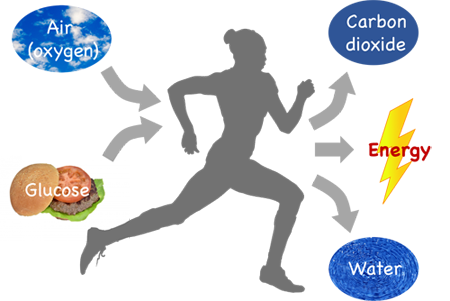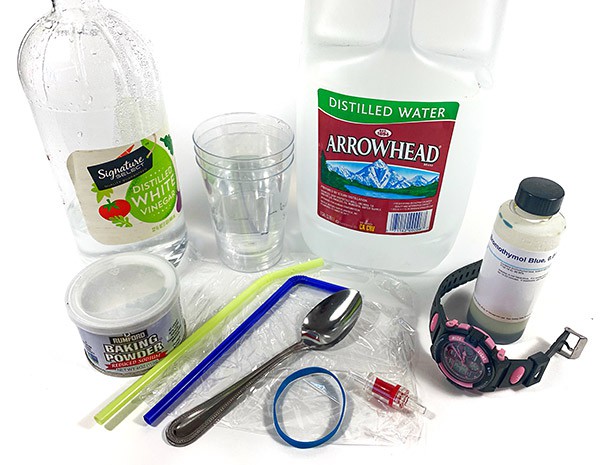Get Energized with Cellular Respiration!
Summary

Cells in the human body rely on an input of oygen and glucose to create energy. When that energy is spent they release by-products of carbon dioxide and water.
Overview
In this fun lesson plan, students will measure how the amount of carbon dioxide in their exhaled breath changes with exercise levels. Carbon dioxide is a product of cellular respiration, so the lesson highlights how breathing is connected to cellular respiration and energy production in our body. Students will make the measurements using a simple colorimetric reaction that can easily be assessed visually.Learning Objectives
- Understand the purpose and mechanism of cellular respiration
- Determine the relationship between breathing (respiration) and cellular respiration
- Analyze graphs of experimentally-recorded data
NGSS Alignment
This lesson helps students prepare for these Next Generation Science Standards Performance Expectations:- MS-LS1-7. Develop a model to describe how food is rearranged through chemical reactions forming new molecules that support growth and/or release energy as this matter moves through an organism.
|
Science & Engineering Practices
Planning and Carrying Out Investigations.
Collect data about the performance of a proposed object, tool, process, or system under a range of conditions.
Asking Questions and Defining Problems. Ask questions that can be investigated within the scope of the classroom, outdoor environment, and museums and other public facilities with available resources and, when appropriate, frame a hypothesis based on observations and scientific principles. Analyzing and Interpreting Data. Analyze and interpret data to provide evidence for phenomena. Constructing Explanations and Designing Solutions. Apply scientific reasoning to show why the data or evidence is adequate for the explanation or conclusion. |
Disciplinary Core Ideas
LS1.C: Organization for Matter and Energy Flow in Organisms.
Within individual organisms, food moves through a series of chemical reactions in which it is broken down and rearranged to form new molecules, to support growth, or to release energy.
PS3.D: Energy in Chemical Processes and Everyday Life. Cellular respiration in plants and animals involve chemical reactions with oxygen that release stored energy. In these processes, complex molecules containing carbon react with oxygen to produce carbon dioxide and other materials. |
Crosscutting Concepts
Energy and Matter.
Matter is conserved because atoms are conserved in physical and chemical processes.
Within a natural or designed system, the transfer of energy drives the motion and/or cycling of matter. Cause and Effect. Cause and effect relationships may be used to predict phenomena in natural or designed systems. Systems and System Models. Models can be used to represent systems and their interactions—such as inputs, processes and outputs—and energy, matter, and information flows within systems. |
Materials
 Image Credit: Svenja Lohner, Science Buddies / Science Buddies
Image Credit: Svenja Lohner, Science Buddies / Science Buddies
Materials per group of 2–4 students:
- Straws (2 per student)
- Check valves for straw (minimum 1 per group, can be re-used); available from Amazon
- 9 oz transparent cup or 150 mL beaker
- Rubber band
- Plastic wrap
- Bromothymol blue indicator solution (0.04%), available from Amazon
- Deionized, or distilled water; available at grocery stores
- Teaspoon
- Stopwatch
Materials for teacher demonstration:
- 9 oz transparent cups or 150 mL beakers (5)
- Baking soda
- Distilled vinegar
- Tablespoon
- All of the materials listed for one student group
Background Information for Teachers
This section contains a quick review for teachers of the science and concepts covered in this lesson.Your body needs lots of energy to perform everyday functions such as walking, talking, or thinking. All of this energy comes from the food you eat. The process of converting food into a form of energy that your body can use is called cellular respiration. Cellular respiration happens continuously inside the cells of your body to provide you with nonstop energy. These cells can also store energy in form of chemical molecules so you can use them whenever you need to. The process of cellular respiration is summarized in Equation 1.
Equation 1:
Cellular respiration happens in several stages. First, all the food you eat has to be broken down into glucose, a type of sugar, which is then broken down into even smaller molecules. This step occurs in the cytoplasm of your cells and already produces some energy. The next stage takes place in the "powerhouses of your cells," the mitochondria. Here, the smaller molecules from glucose are broken down further and, in combination with oxygen, make the end products of cellular respiration carbon dioxide, water and energy. This step releases a much larger amount of energy than the first step.
Equation 1 also explains why you breath, a process that is also called respiration, although it is not the same as cellular respiration. When you breathe, you inhale oxygen from the air, which, as you know from Equation 1, is necessary for breaking down glucose during cellular respiration. The carbon dioxide, which is produced during the further breakdown of glucose, ends up in the air you exhale. In this lesson plan, your students will make this end product of cellular respiration visible, and can even assess the amount of CO2 they produce when breathing! While doing this, they will make use of the fact that carbon dioxide is an acidic gas.
This means that when carbon dioxide is dissolved in water, it forms carbonic acid (H2CO3), which is acidic. You know carbonated water in the form of soda or sparkling water, which contains a lot of CO2. The carbonic acid is what gives these drinks their tangy taste. You can make the acid visible with an indicator solution, such as bromothymol blue, that changes color depending on if the solution is acidic, neutral, or basic. Using this indicator, your students will determine the rate of cellular respiration by measuring how long it takes to turn a neutral solution acidic when blowing into it through a straw, and record the color change of the solution. They will also assess how their CO2 output changes once they challenge their body to produce more energy through exercising. Increasing the cellular respiration rate through exercise will result in higher amounts of carbon dioxide in their breath, which makes the indicator change color faster. This observation will allow your students to link the energy requirements of their bodies to the cellular respiration rate.




